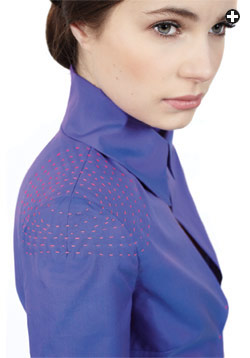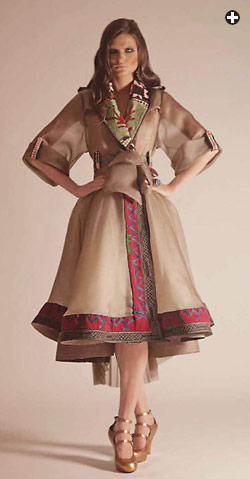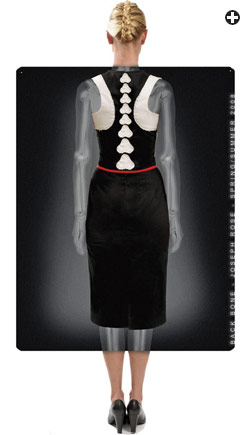 |
|
courtesy maison rabih kayrouz
|

VER THE LAST DECADE, A NEW GENERATION OF DESIGNERS HAS EMERGED TO RESHAPE THE MIDDLE EAST'S FASHION
SCENE. DESPITE A REPUTATION FOR PRODUCING ONLY EXTRAVAGANT BALL GOWNS, A HANDFUL OF EMERGING ARAB
TALENTS ARE EXPLORING AN EDGIER AND MORE MODERN APPROACH TO DESIGN.
 |
|
courtesy maison rabih kayrouz
|
Inside the former Paris theater where Samuel Beckett's Waiting for Godot premiered
in 1953, 38-year-old Rabih Kayrouz is showcasing avant-garde creations of a different kind.
After years of working just under the fashion industry's radar, Kayrouz was voted into the
notoriously choosy Chambre Syndicale de la Haute Couture Parisienne (the Paris fashion
industry's governing body) in 2009, making him only the second Arab designer, after Elie
Saab in 2003, to receive this distinction.
During October's round of Paris ready-to-wear collections, Kayrouz's light-filled showroom
buzzed with international buyers and editors. Among them was hh
Princess Deena Aljuhani Abdulaziz, founder of D'NA, a retail store and gallery in Riyadh.
"I first met Rabih on a visit to Beirut," recalls Abdulaziz. "When you entered his studio,
you immediately got the sense that this was a designer very different from the others.
There wasn't a bead or a ruffle in sight. Instead, his clothes showed a modern and refined
approach to luxury that was rare among Arab designers."
 |
 |
|
courtesy maison rabih kayrouz (2)
|
|
Seeking what he calls "a place where the technical discipline of haute couture is adapted to our
modern-day world," Rabih Kayrouz's designs have been widely praised by fashion critics from Paris
to Beirut and Riyadh.
|
Pitching the glamorous side of a country long associated with war, the Lebanese capital has
positioned itself at the center of the creative movement that is changing the way Middle Eastern
fashion is perceived both within the region and abroad. "Beirut has a unique magic," explains
Heba Elkayal, style editor for The Daily News Egypt and The International Herald
Tribune. "It's home to one of the region's most liberal and cosmopolitan societies, and
that creates the conditions for new ideas to take root."
"Lebanon's fashion circles are pretty small," explains Milia Maroun, who designs out of Beirut
under the label "Milia M." "As a group, we are very close-knit and supportive of each other,
because we've shared similar experiences. It's a feeling of camaraderie that's not easily found
in the wider fashion world."
According to Carole Corm, an editor at ELLE Arab World in Beirut, this young group of
designers inevitably invites comparisons to the generations that preceded them—"established
designers, such as Elie Saab, George Chakra and Zuhair Murad, who paved the way when their clothes
appeared on Paris runways and the red carpet." The difference, she adds, is that while the older
designers "tended to take a formulaic approach to glamour," Kayrouz, Maroun and others "are part
of a new generation reacting to this esthetic, by producing clothes from a different reference
point. They are Lebanese, but they are also very European in the way they view luxury. Where one
group built its fame on glitz, the other prides itself on a very subdued idea of dressing. It
also feels a bit more intellectual with Rabih and Milia. More thought seems to be put into what
it means to make a garment, into the choice of materials and the craftsmanship," observes Corm.
This evolution in taste also marks a shift in the way fashion consumers—women—
in the region are approaching Arab designers. "For years there was this notion that European
and American designers were better," says Elkayal. "The Lebanese designers were really
responsible for breaking that perception by showing abroad, and producing collections
that were not only well-made but deserved the same price points as their western counterparts."
 |
|
courtesy milia m
|
The change in tastes, asserts D'NA's Abdulaziz, is hardly restricted to Lebanon. "There
also seems to be this perception in the West that women in the Gulf tend to go for gaudy
or over-embellished gowns. In reality, my Saudi clients have very sophisticated tastes
and respond well to Kayrouz's understated elegance."
Maroun, who trained in Paris, returned to Beirut in 1999 intent on launching a career in
ready-to-wear. "When I established my label, I wanted to create beautifully made and feminine
clothes that women could wear every day. My collections attract women who are assertive,
self-confident and comfortable in their own skin," says Maroun, who also travels to Istanbul
to teach a fashion course at Bilgi University.
 |
 |
|
courtesy milia m (2)
|
|
"It's not only about how good one is at pattern making or sketching, but also how intellectually
engaged they are in the process of creation," observes Beirut designer Milia Maroun, founder of Milia M.
|
Kayrouz too has turned his attention to the region's next generation of creative talent.
In 2008, he joined Tala Hajjar to co-found the Starch Foundation as a "laboratory for new
ideas." Every six months, aspiring designers submit portfolios to Kayrouz. With the help
of a committee, he makes selections and guides them through the development, presentation
and promotion of their first collection at the Starch boutique in Beirut's Saifi Village.
"There is a lot of talent in Lebanon, but they are somewhat lost when it comes to setting
up their own labels. I've acquired all this experience in the industry over the years, and
felt a responsibility to share it," explains the designer.
"Rabih understood early on that in order to create a sustainable fashion industry in the
Middle East that could compete at an international level, we first needed to build our
creative talent pool," explains Hajjar, who served as Kayrouz's marketing manager for three
years before devoting herself full-time to Starch. "Through his sharp eye, creative direction
and crucial contacts, he's been able to give these young designers a platform."
Hajjar also believes that Kayrouz sets a good example. "He not only encourages individual
expression, but provides them with marketing and financial advice that's overlooked by
many fashion schools," she continues.
One young designer who has benefited from Starch is Ronald Abdala. "Starch has had a positive
effect on my career, helping me gain a better understanding of the local market and introducing
me to a new clientele," explains Abdala, who still sees challenges facing the region's young designers.
"It's difficult to find high-end stores willing to stock young Lebanese talent, which leaves
many to fend for themselves by either opening boutiques or selling out of their showrooms.
Another challenge is the cost of sourcing large enough quantities of high-quality fabrics to
produce a ready-to-wear collection, let alone manufacture it," he explains.
Some in the region's fashion media are keenly aware of these challenges, and they are working
to promote these talents to wider audiences. "It takes a number of factors for designers to
emerge on the international scene. It's not simply talent and luck, but also major financial
backing and, quite often, the endorsement of others in the industry, whether through direct
promotion or by placing their pieces in magazine articles or on covers," says style editor Elkayal.
Like Paris, which is a magnet for aspiring designers from around the world, the Lebanese
capital is luring young Arab talent from across the region. Mohammed Ashi, a Saudi designer
based in Beirut, is known for his unconventional approach to running his label: Instead of
following a strict pattern of seasons, he produces capsule collections that have earned him
a following both within the region and internationally.
 |
 |
 |
|
courtesy mohammed ashi (3)
|
|
"They don't feel pressured to create collections based on Oriental clichés," says blogger
Confashions from Kuwait in reference to Beirut-based Saudi designer Mohammed Ashi.
|
"Ashi takes a post-modern approach to old-school couture," notes Confashions from Kuwait,
one of the region's most influential (and anonymous) fashion bloggers. "He doesn't do
those over-the-top looks that are synonymous with Middle Eastern fashion. Instead he
finds beauty in imperfections, which is why his clothes are rough and refined at the
same time. There is a handcrafted appeal to his creations that often come in muted tones,
with an emphasis on interesting textures, exposed seams and sculptural forms," she continues.
Ashi's work also points to a shift in the way young Arab designers address cultural
heritage. For his latest effort, the Saudi designer didn't reference Arabian themes,
but rather expressed his inspiration through Emily Dickinson's poem "A Bird Came Down
the Walk." The result was a set of 15 gravity-defying pieces featuring undulating silk
organza collars and ball skirts rising dramatically off the floor on layers of sculpted tulle.
"What's interesting about designers such as Ashi is that they don't feel pressured to
create collections based on Oriental clichés or variations on the kaftan," explains Confashions
from Kuwait. "In a sense they are citizens of the world, and they want to establish their
own individual voices. When they reference Oriental themes, it's done in a very subtle
manner, such as a particular method of construction or an embroidery technique."
Ronald Abdala, who moved back to Lebanon in 2004 after graduating from London's Central
Saint Martins, says this approach is "changing the perception of Arab designers as one-trick
ponies." Having grown up in London, Paris, Lagos, and Beirut, he says, "I always try to
balance my designs in ways that reflect my multicultural background."
These are thoughts echoed by others as they try to address a global audience while
maintaining a unique identity. "I don't design specifically for a Middle Eastern customer,
but for a modern woman of today," explains Kayrouz. "I spend a lot time observing how
women walk or put their hands in their pockets. All of these observations influence my
design process."
"Rabih once told me that his clothing is made so a woman can gather it easily around her
and hop into a cab—minimal fuss, everyday use. I love that. In an age of excess and
pretension, Kayrouz celebrates the woman wearing the dress rather than the dress wearing
the woman," adds Elkayal.
For Maroun, collaborating with artists of the Lebanese diaspora has provided further
inspiration. For her winter 2010 collection, she created a dress using a print of a
photograph by Fouad Elkhoury that depicted a blown-out concrete wall, one of the Lebanese
photographer's many images documenting Beirut's destruction during the civil war. "There
is something hauntingly beautiful about his photographs, so I decided to have them blown
up and printed on fabric, which I then made into a dress. I think this notion of seeing
beauty in destruction is very true to a city like Beirut, which has been destroyed and
rebuilt over the centuries," explains the designer.
 |
 |
|
courtesy tahir sultan (2)
|
|
"Extreme knitwear" by Tahir Sultan.
|
The emergence of new design schools in Beirut, Doha and Riyadh is strengthening the larger
trend, but merely having four walls is not enough, says Maroun, who has also taught at the
Ecole Supérieure des Arts et Techniques de la Mode in Damascus. "We need to nurture intellectual
curiosity among students, so that they can think outside the box in terms of design," observes
Maroun. "It's not only about how good they are at pattern making or sketching, but also how
intellectually engaged they are in the process of creation."
The emergence of Arab names on the global fashion scene has also changed perceptions about a
profession that, until very recently, "wasn't a career families encouraged their children to
go into," writes Confashions from Kuwait. "But as we see success stories emerge, it's becoming
more acceptable."
Mohammed Ashi, born in 1980, admits his journey into fashion was anything but straightforward.
"Although I come from a family of textile dealers and manufacturers, they didn't want me to go
into design initially. My father wanted me to focus on the business end of the family company.
I studied marketing at St. Michael's College in Vermont, but the urge to design always remained
with me. I was determined to create my own brand, so I took fashion courses in Paris and Beirut,"
he says. Later, he worked for Givenchy, Elie Saab and Beirut's Milia Maroun before setting up
his own label.
Others of this new generation have often had training further abroad than Beirut. "In the
last few years we've begun to see graduates from prestigious fashion schools, such as New
York's Parsons School of Design and London's Central Saint Martin's, who have won coveted
internships with some of the biggest names in the business. Many of them have returned home
to influence local fashion trends," explains Heba Elkayal.
 |
|
courtesy STARCH / rabih kayrouz
|
|
Kayrouz poses with Starch Foundation winners.
"To create a sustainable fashion industry in the Middle East," says Starch manager Tala
Hajjar, "we first need to build our creative talent pool."
|
One example is Kuwaiti designer Tahir Sultan, who has become known for an extreme approach
to knitwear that incorporates bold colors and volumes that are best described as architectural.
Indeed, he initially studied architecture before graduating from London's Central Saint
Martins and then working for John Galliano at Christian Dior. In addition to becoming a
resident designer at London's Browns store, he also caught the attention of Vogue
magazine "as the next big thing in knitwear." Yet when it came time to launch his own business,
the designer decided to return to his native Kuwait. "To establish my label in the Middle East
made a lot of sense, because the global recession wasn't as severe here," explains Sultan.
Tala Hajjar expects that the impact of today's young Arab talent will eventually extend
far beyond the region. "Considering how far the fashion industry in the Middle East has
come in a relatively short time, it's not hard to envision a day when Arab designers will
influence and mark fashion history—similar to the way the Antwerp Six and the Japanese
did during the 1980's. As for how long it will take—it may happen faster than anyone
expects," she says. "What is certain is that we are on the right track."

 |
Architect, artist, curator and editor Alex Aubry (alex.a.aubry@gmail.com) is particularly interested in design and culture produced by a new generation in
the Middle East and its diaspora. His articles have appeared in Paris-based Unfair magazine,
Brownbook magazine and the London arts publication Muraqqa. He lives in Chicago. |